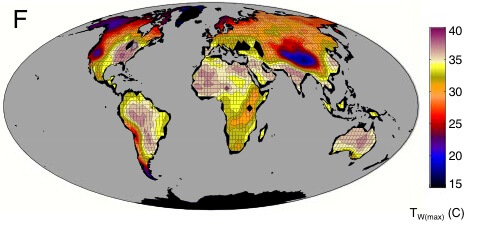Researchers from Purdue University and the University of New South Wales, Australia calculated the highest tolerable "wet-bulb" temperature and found that this temperature could be exceeded for the first time in human history if future climate change scenarios are to be believed.
Wet-bulb temperature is equivalent to what is felt when wet skin is exposed to moving air. It includes temperature and atmospheric humidity and is measured by covering a standard thermometer bulb with a wetted cloth and fully ventilating it.

This map shows the maximum wet-bulb temperatures reached in a climate model from a high carbon dioxide emissions future climate scenario with a global-mean temperature 12 degrees Celsius (21 degrees Fahrenheit) warmer than 2007. The white land areas exceed the wet-bulb limit at which researchers calculated humans would experience a potentially lethal level of heat stress.
(Photo Credit: Purdue University graphic/Matthew Huber)
The study did not provide new evaluations of the likelihood of future climate scenarios, but researchers used climate models to compare the peak wet-bulb temperatures to the global temperatures for various climate simulations. They found that the peak wet-bulb temperature rises approximately 1 degree Centigrade for every degree Centigrade increase in tropical mean temperature.
Researchers also calculated that humans and most mammals, which have internal body temperatures near 98.6 degrees Fahrenheit, will experience a potentially lethal level of heat stress at wet-bulb temperature above 95 degrees sustained for six hours or more.
"Although areas of the world regularly see temperatures above 100 degrees, really high wet-bulb temperatures are rare," said Matthew Huber, a Purdue professor of earth and atmospheric sciences.
"This is because the hottest areas normally have low humidity, like the 'dry heat' referred to in Arizona. When it is dry, we are able to cool our bodies through perspiration and can remain fairly comfortable. The highest wet-bulb temperatures ever recorded were in places like Saudi Arabia near the coast where winds occasionally bring extremely hot, humid ocean air over hot land leading to unbearably stifling conditions, which fortunately are short-lived today."
The challenges presented by the future climate scenarios are daunting in their scale and severity. "We found that a warming of 12 degrees Fahrenheit would cause some areas of the world to surpass the wet-bulb temperature limit, and a 21-degree warming would put half of the world's population in an uninhabitable environment," Huber said.
"When it comes to evaluating the risk of carbon emissions, such worst-case scenarios need to be taken into account. It's the difference between a game of roulette and playing Russian roulette with a pistol. Sometimes the stakes are too high, even if there is only a small chance of losing."
Humans at rest generate about 100 watts of energy from metabolic activity. Wet-bulb temperature estimates provide upper limits on the ability of people to cool themselves by sweating and otherwise dissipating this heat. In order for the heat dissipation process to work, the surrounding air must be cooler than the skin, which must be cooler than the core body temperature.
The cooler skin is then able to absorb excess heat from the core and release it into the environment. If the wet-bulb temperature is warmer than the temperature of the skin, metabolic heat cannot be released and potentially dangerous overheating can ensue depending on the magnitude and duration of the heat stress.
Citation: Steven C. Sherwooda, Matthew Huber, 'An adaptability limit to climate change due to heat stress', PNAS, May 2010; doi: 10.1073/pnas.0913352107





Comments